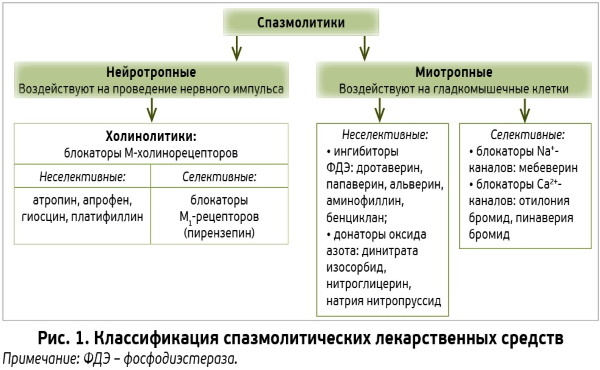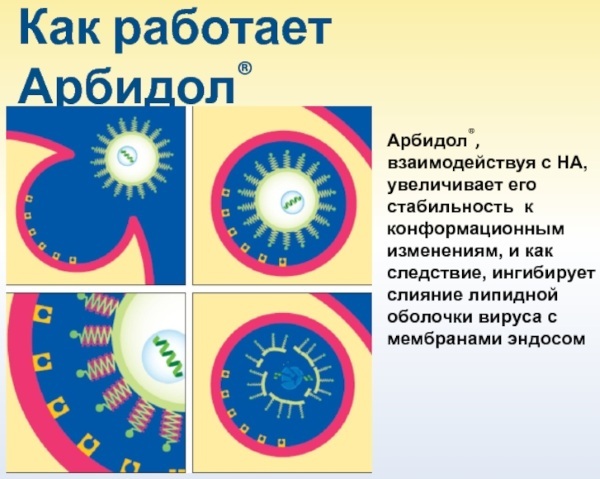Content
- Causes of exacerbation of chronic bronchitis
- Symptoms of an exacerbation of chronic obstructive bronchitis (COPD)
- Classification, types of COPD
- Diagnostic methods to help confirm acute COPD
- Treatment
- Antibiotics
- Other drugs
- Compresses and mustard plasters
- Breathing exercises
- Folk remedies
- Recipe number 1. With onions and marshmallow root.
- Recipe number 2. Mother and stepmother and bow.
- Recipe number 3. Herbal collection.
- Recipe number 4. Honey based.
- Recipe number 5. Based on black radish.
- Prognosis and complications
- Living with COPD
- Myths and dangerous misconceptions in the treatment of chronic bronchitis
- Chronic bronchitis video
Chronic bronchitis is a progressive lung disease which over time, in the absence of timely treatment, leads to the destruction of bronchial tissue. This pathology is characterized by exacerbations up to several times a year, most often against the background of respiratory diseases.
Causes of exacerbation of chronic bronchitis
Exacerbation of chronic bronchitis, the treatment of which was not carried out in a timely manner, can happen quite often. This disease, like many others, has 2 phases - exacerbation and remission. During the period of "lull" there are usually no obvious signs, rarely a cough with little phlegm may appear.
The causes of exacerbation of bronchitis are most often viral, less often bacterial infections. Chronic bronchitis during this phase is usually much more severe and longer than other forms of pathology.
Also, the reasons for the development and exacerbation of chronic bronchitis can be the following factors:
- alcoholism;
- smoking;
- congenital pathologies of the bronchial tree;
- hereditary predisposition;
- work with toxic substances;
- climatic conditions;
- weakening of the immune system;
- other chronic pathologies of a viral or bacterial nature.
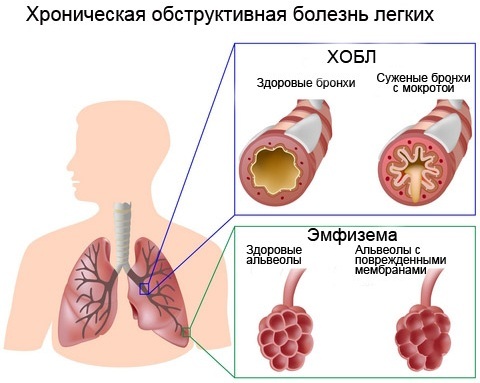
More rare exacerbation factors include diseases of the cardiovascular system and kidneys.
Symptoms of an exacerbation of chronic obstructive bronchitis (COPD)
Due to the fact that chronic bronchitis usually develops for a rather long period and often with latent symptoms, the disease is diagnosed quite late. This usually begins at the age of 35-40 years, and obvious signs appear after 50 years. Chronic bronchitis gives pronounced symptoms during the exacerbation stage.
The most common signs of pathology include:
- cough;
- difficult, thick sputum;
- coughing during the day;
- rapid breathing;
- shortness of breath, worsening even with minor physical exertion;
- heavy wheezing;
- frequent infectious diseases of the respiratory system, especially in the cold season.
More rare symptoms include:
- swelling of the ankles;
- chronic fatigue syndrome;
- significant weight loss.
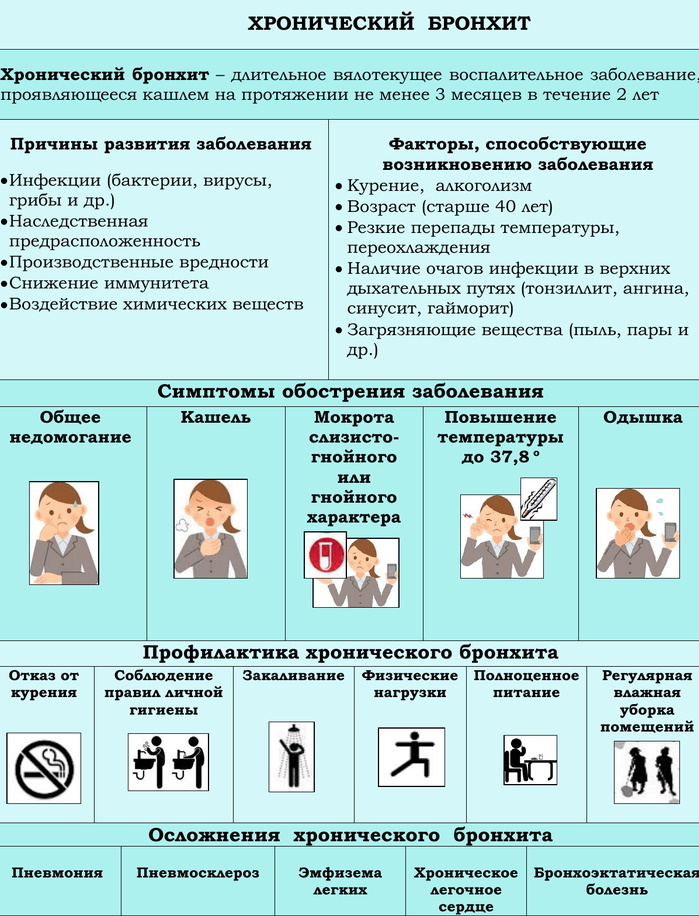
Exacerbation of chronic bronchitis
Due to the fact that the above symptoms are often mild, they are usually ignored and treated seek medical help when chronic bronchitis has already had irreversible changes in the lung tissue. Therefore, if you experience even a slight regular cough or shortness of breath, you should consult a doctor.
Classification, types of COPD
Chronic obstructive pulmonary disease is classified according to its severity and lung tissue damage.
In total, there are several stages of development of COPD:
- 0 - an increased risk of developing chronic bronchitis. It is characterized by such a symptom as a chronic cough with little sputum production. In this case, the work of the pulmonary system is within normal limits.
- Easy (I) - the function of the lower respiratory organs is slightly impaired. The main symptoms are a cough with sputum production.
- Moderate (II) - proceeds with more pronounced symptoms. Shortness of breath is added to the cough, which increases with physical exertion.
- Severe (III) - characterized by increased symptoms and increased incidence of exacerbation.
- Extremely severe (IV) - the patient's condition becomes noticeably worse, up to death. The development of concomitant diseases, in particular cor pulmonale, is possible.
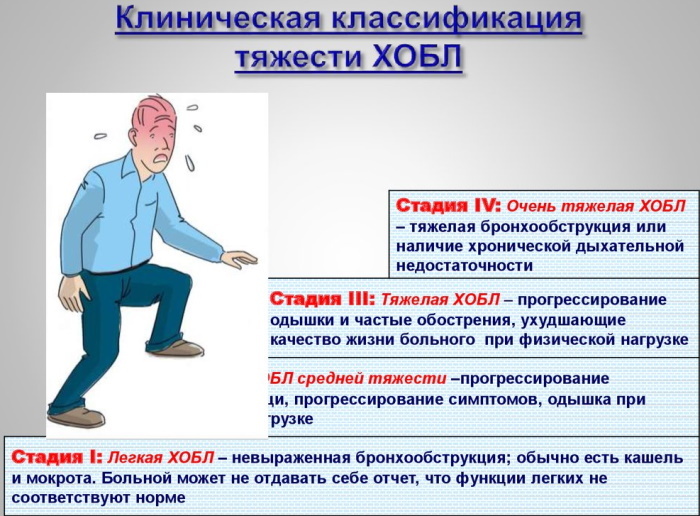 One of the main diagnostic methods, spirography helps to most accurately determine the stage of development of chronic bronchitis.
One of the main diagnostic methods, spirography helps to most accurately determine the stage of development of chronic bronchitis.
| Stage of the disease | Sample (index) Typhno (FEV1 / FZHEL) |
| 0-I | ≥ 80% of due |
| II | 50% ≤ FEV1 <80% of due |
| III | 30% ≤ FEV1 <50% of due |
| IV | <30% of due |
According to the International Classification of Diseases, the most basic qualifying sign of all stages of chronic obstructive pulmonary disease is a decrease in the ratio of FEV1 / FVC <70%.
Diagnostic methods to help confirm acute COPD
Exacerbation of chronic bronchitis, the treatment of which depends on the stage of the disease, is determined on the basis of several research methods. First of all, a patient is interviewed in order to find out the presence of symptoms and provoking factors (smoking, inhalation of toxic substances, and others).
The diagnostic methods for chronic bronchitis include:
- Laboratory tests - general urine and blood tests. With a moderate and severe stage, a study of the gas and acid-base composition of the blood is carried out.
- Spirometry. Helps to identify the degree of impairment of external respiration.
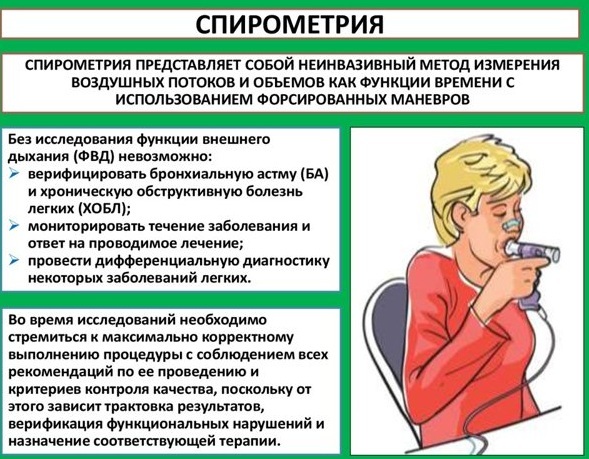
Spirometry - Pneumotachography. Determines the maximum expiratory flow rate.
- Bronchoscopy. Helps to clarify the nature and degree of development of inflammatory processes in the lower respiratory tract.
- Laboratory tests of sputum - microscopic and bacteriological. The first method helps to identify pathological changes in sputum (color, consistency, the presence of purulent contents) and the number of neutrophilic leukocytes. The second test determines the type of infection that triggered the development of the disease.
- Radiography of the lungs. Allows you to confirm the diagnosis and exclude the presence of other pathologies of the lower respiratory tract (tuberculosis, malignant or benign neoplasms, pneumonia).
- Bronchography. Helps to identify the presence of changes in the structure of the bronchial tree.
Based on the results of all diagnostic methods, the doctor determines the degree of the disease and prescribes the appropriate treatment.
Treatment
Exacerbation of chronic bronchitis, the treatment of which depends on the stage of the disease and the patient's condition, a serious condition that requires an integrated approach.
Therapy during an exacerbation is aimed at:
- elimination of inflammatory processes in the tissues of the lower respiratory organs;
- support for the work of the heart;
- elimination of bronchial spasms;
- normalization of lung ventilation;
- improvement of sputum discharge.
During remission with chronic bronchitis, it is recommended to engage in breathing exercises, carry out spa treatment and timely eliminate infectious diseases of the upper respiratory ways.
Antibiotics
Antibiotics are prescribed if a bacterial infection was the cause of the disease.
For the treatment of chronic bronchitis, the following medications are most often used:
- Sumamed;
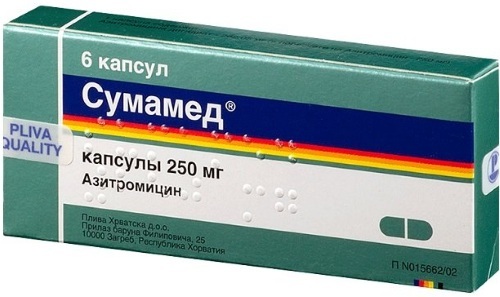
- Doxycycline;
- Biseptol;
- Furazolidone;
- Rulid.
If the treatment with the above drugs does not give a positive effect, then an antibiotic of the reserve group is used - Gentamicin. Treatment with this drug is carried out only in a hospital setting, since the drug is directly delivered to the bronchi.
In the event that it is not possible to examine sputum for the type of pathogen, antibiotics of the penicillin group are used for therapy.
Other drugs
Exacerbation of chronic bronchitis, the treatment of which is carried out only under the supervision of a doctor, requires an integrated approach. Therefore, not only antibiotics are used for therapy, but also other drugs.
In case of impaired airway patency, bronchodilators are prescribed:
- Berodual;
- Salbutamol;
- Atrovent.
With the low effectiveness of the above listed drugs, Theophylline may be indicated.
To dilute sputum and facilitate its discharge, expectorants are prescribed:
- plantain or marshmallow syrups;
- potassium iodide;
- Bromhexine;
- Lazolvan;
- Fluimucil;
- ACC.

If COPD was triggered by viral infections (ARVI, influenza and others), antiviral drugs are prescribed:
- Aflubin;
- Anaferon;
- Amizon;
- Groprinosine.
Exacerbation of chronic bronchitis, which is treated with drugs "heavy" for the body, negatively affects the immune system. Therefore, it is imperative to prescribe immunostimulating drugs.
These include:
- various immunomodulators of plant origin (for example, Echinacea purpurea);
- vitamins A, C;
- T-activin;
- Timalin.
Also, in the treatment of exacerbation of chronic bronchitis, medicinal support of the liver is necessarily carried out, since some drugs have a destructive effect on its cells.
To reduce the negative impact on this organ, the following hepatoprotectors are used:
- Hepatophyte;
- Milk thistle extract;
- Darsil;
- Carsil.

Also, in chronic bronchitis, inhalation is used as an auxiliary method, it is advisable to use a nebulizer for this. With its help, drugs are delivered directly to the lungs. For treatment, expectorant, anti-inflammatory, antibacterial drugs can be prescribed.
Compresses and mustard plasters
Mustard plasters and compresses are also used as an aid in COPD. Compresses are very popular in the treatment of various lung diseases.
They have a number of positive effects on this organ:
- relax his muscle tissue;
- increase blood circulation;
- facilitate the passage of sputum;
- relieve bronchospasm.
Compresses are applied in the following order:
- Protective layer (you can use gauze folded several times).
- Medication-impregnated cloth.
- Parchment paper or cellophane lining.
- Warming (scarf, cotton wool or thick towel).
If the procedure is not followed, there is a high risk of getting a burn, skin irritation or provoking the development of an allergic reaction, most often hives.
Recommended areas for applying a compress include:
- caviar;
- feet;
- breast;
- the area under the shoulder blades;
- the front of the neck.
It is forbidden to use compresses in the area of the spine and the location of the heart.
It is advisable to make compresses before bedtime, it is optimal to leave them for 7-8 hours.
For therapy, both medications and folk remedies are used.
The most effective are:
- Dimexide;
- boiled potatoes;
- vegetable oil (necessarily warmed up);
- black radish juice;
- camphor alcohol;
- vodka;
- honey;
- sea salt;
- Vishnevsky ointment.
As with any medical procedure, compresses have a number of contraindications.
These include:
- pregnancy;
- the presence of open wounds in the area of imposition;
- allergy to components;
- dermatological diseases;
- tuberculosis;
- blood diseases;
- endocrine pathologies;
- cardiovascular diseases;
- oncology;
- increased body temperature.
After the compress, it is desirable to stay in bed for another 2-3 hours; you must refrain from walking for several hours.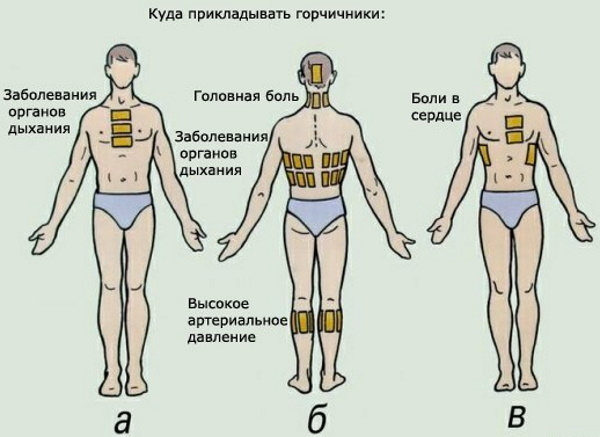
Mustard plasters are no less effective in COPD, the main active ingredient of which is mustard oil.
It is capable of exerting a number of the following positive effects on the body:
- stimulation of blood circulation;
- activation of metabolism in tissues;
- expansion of the airways, due to which breathing is facilitated;
- destruction of pathogens.
With an exacerbation of obstructive chronic bronchitis, mustard plasters can be used only if the body temperature is within normal limits.
The main contraindications to the use of this remedy include:
- children under 6 years of age;
- bleeding;
- oncology;
- allergy;
- tuberculosis.
Places of imposition of mustard plasters are the same as for compresses.
The procedure is performed once a day before bedtime. Duration in adults - 15 minutes, in children - 4-6 minutes. The course of treatment is no more than 5 days.
Breathing exercises
Exacerbation of chronic bronchitis, the treatment of which is carried out by different methods, is effectively eliminated with the help of breathing exercises. It has been proven that if you do it regularly, you can get rid of COPD forever.
At present, experts consider Strelnikova's breathing exercises one of the most effective complexes. She has developed a special set of physical exercises, combined with a special way of breathing.
Exercises from the Strelnikova complex will help to solve several problems inherent in the exacerbation of chronic bronchitis at once:
- accelerate the elimination of pathogens;
- relieve inflammation;
- stimulate the recovery of mucous membranes;
- make breathing easier.
Also, doctors recommend using other types of physical activity - swimming, exercise, walking.
Folk remedies
As an additional remedy for exacerbation of chronic bronchitis, alternative methods can be used. It is important to remember that they are used only after consultation with the attending physician.
Recipe number 1. With onions and marshmallow root.
Mode of application:
- 30 g of marshmallow pour 200 ml of boiling water;
- insist 60 minutes;
- grate 1 head of onion on a fine grater;
- add to herbal infusion;
- withstand 1 hour;
- strain.
Take 20 ml of the product 3 times a day.
Recipe number 2. Mother and stepmother and bow.
Mode of application:
- 40 g of herbs pour 200 ml of boiling water;
- insist 1 hour;
- grate 1 head of onion on a fine grater;
- lead to infusion;
- withstand 1 hour;
- strain.
Drink 20 ml of the product 3 times a day.
Recipe number 3. Herbal collection.
Mode of application:
- mix in equal parts chamomile, oregano and lungwort;
- 40 g of collection pour 200 ml of boiling water;
- insist;
- strain.
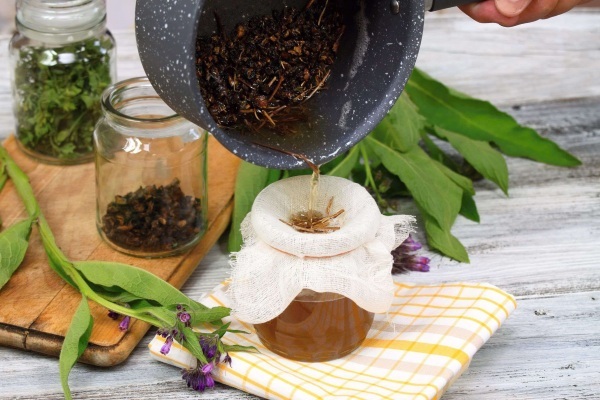
Drink 60 ml up to 7 times a day.
Recipe number 4. Honey based.
Mode of application:
- mix 100 g each butter, lard and honey;
- add 20 ml of aloe juice;
- heat 200 ml of milk;
- add 20 g of the mixture to it.
Take 2 times a day.
Recipe number 5. Based on black radish.
Mode of application:
- 15 g of licorice root, plantain and coltsfoot, pour 200 ml;
- boil over low heat;
- insist;
- strain;
- add 150 ml of radish juice.
Drink the product 2 times a day, 80 ml.
Folk recipes help relieve coughs, relieve inflammation and improve sputum flow.
Prognosis and complications
Exacerbation of chronic bronchitis, in the absence of timely treatment, can lead to rather serious complications.
The most common are:
- heart and lung failure;
- bronchiectasis;
- development of pulmonary emphysema;
- bronchial asthma;
- pneumonia.
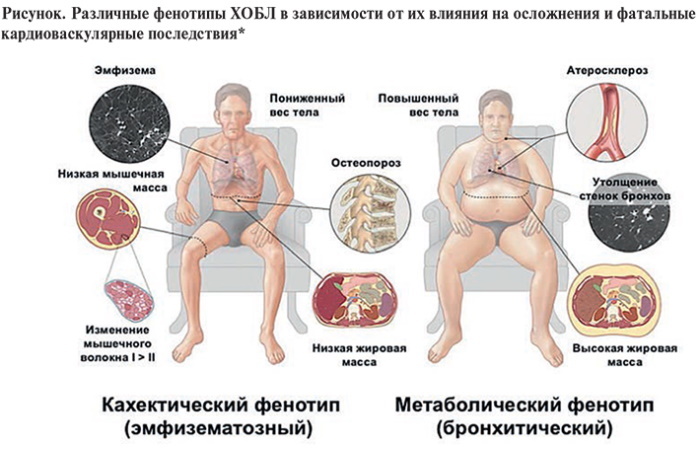
With timely adequate treatment and elimination of provoking factors, the prognosis for chronic bronchitis is quite favorable. Despite the fact that it is almost impossible to achieve a complete cure with this disease, the period of remission is significantly increased and the frequency of exacerbations decreases.
Living with COPD
There is a special rehabilitation program for people suffering from chronic bronchitis.
It includes:
- breathing exercises;
- physical exercise;
- special diet.
Exercise therapy for patients with COPD includes:
- power training;
- hand exercises;
- bicycle riding;
- walking.
To reduce the risk of exacerbation and the severity of symptoms, it is recommended to avoid:
- the use of hair sprays;
- refuse cleaning and detergents with strong fragrances;
- do not use perfume with a strong aroma, any sprays, including air fresheners;
- inhalation of smoke and exhaust gases;
- being in too dusty rooms.
One of the most obvious symptoms of COPD is shortness of breath, which increases with any physical exertion. To restore breathing, it is recommended to use exercises from breathing exercises for relaxation.
Myths and dangerous misconceptions in the treatment of chronic bronchitis
Many people believe that bronchitis is common and that coughing with this disease can go away on its own. This is a very dangerous misconception, since patients refuse treatment, which is fraught with the formation of serious complications.
Also, many believe that coughs can be treated on their own with antibiotics and other medications. This is also not true, as cough is one of the main symptoms of various lung diseases. And for each disease, drugs are selected individually.
In addition, it is believed that only smokers are susceptible to COPD.
In fact, the statistics say that:
- 42% of patients have quit smoking long ago;
- 34% - currently smoke;
- 24% have never smoked at all.
It is important to remember that smoking cessation is essential for people with COPD. This will help significantly alleviate symptoms and reduce relapses.
Also, many patients believe that physical education is contraindicated in chronic bronchitis. In fact, exercise therapy specialists offer special sets of exercises that have a minimal risk of developing shortness of breath.
In addition, exercises from breathing exercises will help to facilitate and restore breathing during physical exertion; Strelnikova's technique can be used. One of the most effective exercises is to take deep deep breaths and exhale slowly while standing or sitting. It will take several approaches.
Exacerbation of chronic bronchitis most often occurs in those patients who do not receive timely treatment. Therefore, if even minor symptoms of problems with the lower respiratory organs appear, you should immediately seek medical help.
Chronic bronchitis video
What to do with chronic bronchitis:


